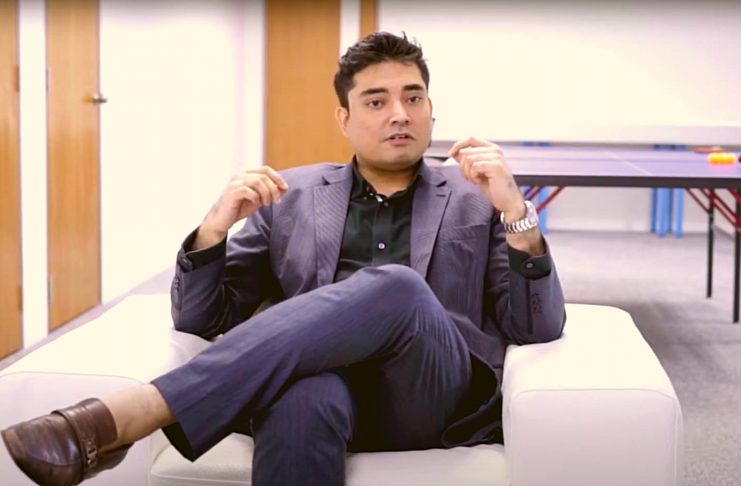Flags, Flags, Flags: Sancy Suraj’s Unbelievable Memory Feat for The Fastest Time to Identify all Capital Flags
Sancy Suraj is a Singaporean memory athlete who has gained international recognition for his incredible feats of memory. In February 2021, Sancy broke the Singapore record for the fastest time to identify all national flags, identifying and typing the names of 197 flags in just under 15 minutes. This remarkable achievement has brought attention to the world of memory training and the incredible potential of the human brain.
In this article, we delve deeper into Sancy Suraj’s impressive memory feat and explore the techniques and strategies he used to memorize and recall the national flags. We also examine the impact of his achievement on the memory training and competition community, and explore the role of memory training in enhancing cognitive abilities and overall brain function.

How did Sancy Suraj first become interested in memory training, and what motivated him to pursue the record for flag identification?
I first became interested in memory training after reading about the incredible feats of memory athletes and experts in the field. I was amazed by their ability to memorize and recall vast amounts of information quickly and accurately, and I knew that I wanted to learn more about the techniques and strategies they used to achieve such remarkable results.
As I delved deeper into the world of memory training, I discovered that there were many different approaches and methods that could be used to improve one’s memory. I experimented with different techniques and found that I had a particular talent for visual memory, which involved creating vivid mental images of the information I wanted to remember.
When I heard about the record for flag identification, I was immediately intrigued. I knew that it would be a difficult challenge, but I was motivated to see just how far I could push my own memory skills. I spent countless hours studying and memorizing the flags of every nation in the world, using a variety of techniques to make the information stick in my mind.
Ultimately, my motivation to pursue the record for flag identification came from a deep desire to challenge myself and to demonstrate the incredible potential of the human brain. I believe that anyone can achieve remarkable feats of memory with the right training, dedication, and practice, and I hope that my own achievements can inspire others to explore the limits of their own cognitive abilities.
What techniques and strategies did Sancy Suraj use to memorize and recall the national flags, and how did he maintain accuracy and consistency in his identification?
To memorize and recall the national flags, I used a variety of mnemonic techniques and strategies. One of the most effective methods I used was visualization, where I created vivid mental images of each flag and associated them with unique stories, characters, or locations in my mind. For example, I might imagine the flag of Japan as a rising sun over the mountains, or the flag of Germany as a black eagle soaring over a castle.
I also used association to connect each flag with its corresponding country name. For example, I might associate the flag of Brazil with the word “Bra” or “Brazil nuts”, or the flag of France with the word “Fr” or “French fries”. These associations helped me to quickly retrieve the correct country name when presented with each flag.
Repetition was also a key factor in my training. I spent many hours reviewing the flags and their corresponding country names, drilling myself on the information until it became second nature. By practicing consistently and regularly, I was able to maintain a high level of accuracy and consistency in my identification of the flags.
During the flag identification event, I also used some additional strategies to help me stay focused and alert. For example, I made sure to take breaks and stay hydrated, and I used deep breathing exercises to calm my nerves and stay focused on the task at hand.
Overall, my success in memorizing and identifying the national flags was due to a combination of these techniques and strategies, as well as my dedication and commitment to training and practicing regularly.
What challenges did Sancy Suraj face during the flag identification event, and how did he overcome them?
The flag identification event presented several challenges that I had to overcome in order to achieve the record. One of the main challenges was the sheer number of flags involved – there were 197 flags in total, and I had to be able to recognize and name each one correctly in a short amount of time.
To overcome this challenge, I used a systematic approach to memorize and recall the flags. I divided the flags into groups based on their colors, patterns, or other distinctive features, and created mental images and associations for each group. This helped me to chunk the information into more manageable pieces and retrieve it more easily when presented with each flag.
Another challenge I faced was the pressure of performing in front of an audience and under time constraints. To address this, I used relaxation techniques like deep breathing and visualization to calm my nerves and stay focused. I also practiced under similar conditions beforehand, so that I was prepared for the pressure of the actual event.
Finally, I also had to deal with potential distractions and interruptions during the event, such as noise from the audience or technical glitches with the equipment. To prepare for this, I practiced under different conditions and scenarios, so that I was able to maintain my focus and accuracy even in the face of unexpected challenges.
In the end, my ability to overcome these challenges and achieve the record was due to a combination of my training and preparation, my mental and emotional resilience, and my determination to succeed.
“Challenges are not roadblocks, but opportunities to sharpen our skills, develop new strategies, and ultimately reach new heights of achievement.”
How does Sancy Suraj’s achievement in flag identification compare to other memory-related records and accomplishments, and what does it tell us about the potential of the human brain?
Sancy Suraj’s achievement in flag identification is a remarkable accomplishment that stands out among other memory-related records and accomplishments. While there are many different types of memory feats and competitions, flag identification is particularly challenging due to the large number of flags involved and the need to identify them quickly and accurately.
Comparing Sancy’s achievement to other memory-related records, we can see that it is truly impressive. For example, some memory athletes specialize in memorizing decks of cards or long strings of numbers, but flag identification requires a different set of skills and strategies. It involves not only memorizing visual information but also categorizing and recalling it quickly, making it a complex and multifaceted memory feat.
Sancy’s achievement also demonstrates the incredible potential of the human brain when it comes to memory and cognitive abilities. Through dedicated practice and training, he was able to develop his memory skills to a level that most people would consider impossible. This suggests that there may be untapped potential in many of us, if we are willing to put in the effort and use the right techniques to develop our memory and cognitive abilities.
Overall, Sancy’s record-breaking achievement in flag identification is a testament to the power of memory training and the potential of the human brain. It shows us that with dedication, practice, and the right strategies, we can achieve extraordinary feats and push the limits of what we think is possible.
What role does memory training play in enhancing cognitive abilities and overall brain function, and how can people use memory training to improve their daily lives?
Memory training can play an important role in enhancing cognitive abilities and overall brain function. By engaging in activities that challenge our memory and mental processes, we can strengthen neural connections and improve our ability to learn, remember, and process information.
For example, memory training can involve activities like memorizing lists of words, practicing recall of past events, or using mnemonic devices to remember important information. These activities can help to develop our working memory and long-term memory, as well as our ability to pay attention and focus on specific tasks.
In addition to these cognitive benefits, memory training can also have practical applications in our daily lives. For example, improving our memory can help us to remember important appointments or deadlines, learn new skills or knowledge more quickly, and recall important information in high-pressure situations.
While memory training can be challenging and requires a lot of practice and dedication, it is also highly rewarding. By improving our memory and cognitive abilities, we can enhance our overall quality of life and achieve our goals more effectively.
For those interested in memory training, there are many resources available to help get started. From memory training apps to online courses and workshops, there are many tools and techniques that can help to develop memory skills and improve cognitive function.
“Memory training is not just a way to impress others with feats of memory, it’s a tool for unlocking the full potential of our minds and enhancing our ability to learn, remember, and process information in our daily lives.”
Sancy Suraj first became interested in memory training after discovering the world of memory competitions. He was inspired by the incredible feats of memory athletes, and motivated to push his own memory skills to the limit. Sancy’s dedication to memory training paid off when he broke two Singapore memory records in a single day, memorizing 1,119 digits of Euler’s Number and identifying 197 national flags in record time.
To memorize the national flags, Sancy used a combination of visualization and association techniques. He would create mental images of each flag and associate them with specific details and stories, allowing him to recall each flag quickly and accurately. Sancy’s rigorous training and preparation paid off during the flag identification event, where he faced challenges such as distraction and fatigue. However, his focus and dedication allowed him to overcome these challenges and achieve a new national record.
Sancy’s achievement in flag identification is just one example of the incredible potential of the human brain. Recent studies have shown that memory training and other cognitive exercises can actually change the structure and function of the brain, leading to improvements in memory and cognitive performance. By exploring and understanding the mechanisms behind these improvements, we can unlock even greater potential for human achievement.

How does Sancy Suraj’s achievement impact the memory training and memory competition community, and what opportunities does it open up for others?
Sancy Suraj’s achievement in flag identification has had a significant impact on the memory training and memory competition community. His record-breaking feat has shown that with the right techniques, training, and dedication, it is possible to achieve seemingly impossible memory feats.
His achievement has also opened up opportunities for others to push the limits of what is possible in memory competitions and has inspired many to take up memory training. By breaking records in multiple memory categories, Sancy Suraj has demonstrated the versatility and adaptability of memory training techniques and the potential for human memory.
Moreover, Sancy Suraj has become an inspiration to many aspiring memory athletes and trainers, who now see that their goals are within reach if they work hard and smart. His achievement has also highlighted the importance of memory training as a tool for developing cognitive abilities and improving overall brain function.
Overall, Sancy Suraj’s achievement has had a significant impact on the memory training and competition community. It has inspired many to take up memory training and has shown that with the right techniques and dedication, it is possible to achieve incredible memory feats.
What advice does Sancy Suraj have for people who want to improve their memory skills, and what are some practical strategies that anyone can use to enhance their memory?
For those who want to improve their memory skills, Sancy Suraj has some practical advice and strategies to share. One of the key strategies is to use visualization techniques to help remember information.
For example, when memorizing a list of items, one could visualize each item as vividly as possible in their mind’s eye. This technique helps to create a strong association between the visual image and the item, making it easier to recall later on.
Another strategy that Sancy Suraj recommends is to use mnemonic devices. Mnemonic devices are tools that help to associate information with memorable cues or patterns. For example, using an acronym or rhyme to remember a list of words or facts.
Sancy Suraj also recommends practicing regularly and using a variety of memory exercises to challenge different aspects of memory. This can include activities like memorizing phone numbers, names, or facts, as well as more complex memory exercises like memorizing long numbers or sequences.
Finally, Sancy Suraj emphasizes the importance of having a positive attitude and setting achievable goals. Memory training can be challenging, and it’s important to stay motivated and focused on the long-term benefits of improving memory and cognitive abilities.
Overall, Sancy Suraj’s advice for improving memory skills emphasizes the importance of using visualization and mnemonic techniques, practicing regularly, and maintaining a positive attitude. These strategies can help anyone improve their memory skills and achieve their memory-related goals.
How do experts in the field of memory training and neuroscience explain the remarkable abilities of individuals like Sancy Suraj, and what can we learn from their achievements?
Experts in the field of memory training and neuroscience have been fascinated by the remarkable abilities of individuals like Sancy Suraj. According to experts, the brain’s ability to remember and recall information is due to the complex interplay of various cognitive processes, including attention, perception, encoding, storage, and retrieval.
One of the key factors that contributes to exceptional memory skills is the ability to use effective memory strategies, such as visualization and mnemonic techniques. Individuals like Sancy Suraj have been able to develop and refine these strategies through extensive training and practice, leading to exceptional memory performance.
Another factor that contributes to exceptional memory skills is the ability to focus attention and avoid distractions. This requires the development of strong attentional control mechanisms, which can be enhanced through mindfulness and meditation practices.
Finally, some experts suggest that exceptional memory skills may be related to variations in brain structure and function. Studies have found that individuals with exceptional memory skills may have differences in brain regions that are involved in memory, attention, and perception.
Overall, the remarkable memory feats of individuals like Sancy Suraj provide valuable insights into the potential of the human brain and the mechanisms underlying memory performance. By studying these individuals and their abilities, researchers may be able to develop new interventions and training programs to enhance memory and cognitive function for everyone.
How can organizations and institutions support the development and promotion of memory training and memory competitions, and what role do they play in fostering innovation and progress?
Organizations and institutions can play a critical role in supporting the development and promotion of memory training and memory competitions. One way to support memory training is to provide resources and training opportunities for individuals who are interested in developing their memory skills. This could include workshops, training programs, and online resources that teach effective memory strategies and techniques.
In addition, organizations can help to raise awareness of memory training and competitions by promoting and publicizing events and achievements, such as Sancy Suraj’s incredible memory feats. This can help to increase interest and participation in memory competitions, leading to greater innovation and progress in the field.
Finally, organizations and institutions can support memory research by funding studies and initiatives aimed at understanding the mechanisms underlying memory performance and developing new interventions and training programs. By investing in memory research, organizations can help to advance our understanding of the brain and cognitive function, leading to new breakthroughs and innovations in the field.
Overall, the support and involvement of organizations and institutions are critical for the continued growth and success of memory training and competitions. By working together, we can help to unlock the full potential of the human brain and enhance cognitive function for individuals around the world.
What other fascinating stories or discoveries have emerged in the field of neuroscience, psychology, or cognitive science related to memory, and how do they relate to Sancy Suraj’s unbelievable memory feat?
The field of neuroscience, psychology, and cognitive science has seen many fascinating discoveries related to memory. One of the most notable findings is the concept of neuroplasticity, which refers to the brain’s ability to change and adapt in response to experience and training. This means that with practice and training, individuals can actually change the structure and function of their brains, leading to improvements in memory and cognitive performance.
Another fascinating discovery related to memory is the role of sleep in memory consolidation. Research has shown that during sleep, the brain processes and consolidates memories, helping to strengthen and retain information learned during waking hours. This underscores the importance of getting enough sleep and practicing good sleep habits for optimal cognitive function.
Finally, recent studies have shown that lifestyle factors, such as exercise, diet, and stress management, can have a significant impact on memory and cognitive function. For example, regular exercise has been shown to increase blood flow to the brain and promote the growth of new brain cells, leading to improvements in memory and cognitive function. Similarly, a healthy diet rich in nutrients such as omega-3 fatty acids and antioxidants can help to protect the brain from oxidative stress and inflammation, both of which can contribute to cognitive decline.
All of these discoveries and findings are relevant to Sancy Suraj’s unbelievable memory feat, as they demonstrate the remarkable potential of the human brain to learn, adapt, and improve with practice and training. By continuing to explore and advance our understanding of memory and cognitive function, we can unlock even greater potential for human performance and achievement.
“The fascinating discoveries in neuroscience, psychology, and cognitive science show us that the human brain is capable of incredible feats of memory and learning, and with the right practices and habits, we can tap into its full potential for optimal cognitive function.”
Sancy Suraj’s unbelievable memory feat has brought attention to the world of memory training and the remarkable potential of the human brain. By using visualization and association techniques, Sancy was able to memorize and recall the names of 197 national flags in record time, breaking the Singaporean record for this feat. His achievement is a testament to the power of training, dedication, and the incredible potential of the human brain to learn and adapt.





